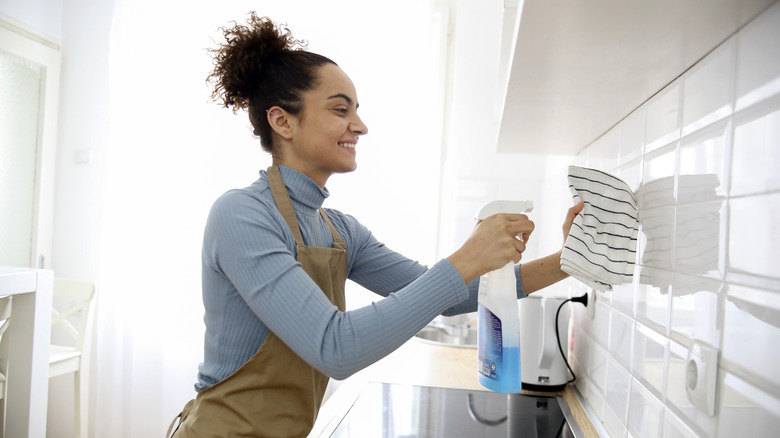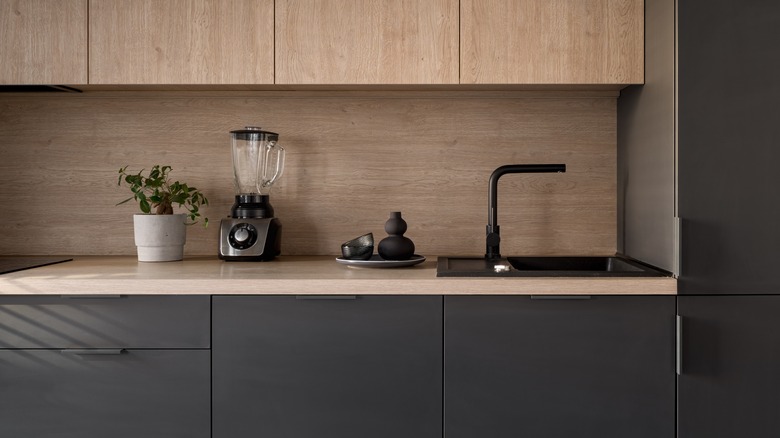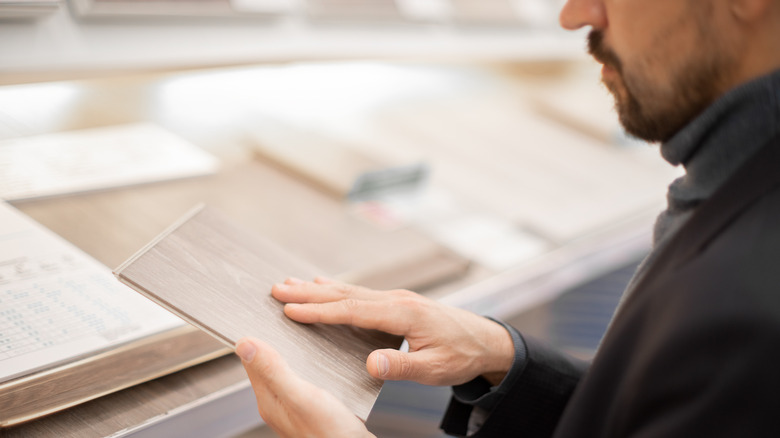The Easy-To-Clean Backsplash You'll Want To Consider For Your Kitchen
Mid-century modern interior design fans, take note! This is arguably one of the most creative ways to bring mid-century modern design into your kitchen. And it's for sure an unexpected kitchen backsplash material that embraces Scandinavian design. If you haven't guessed, we're talking about the highly underrated and under-the-radar — though far from underperforming — teak. That's right; the tropical hardwood that simultaneously gives off tiki bar and Nordic cabin vibes. We won't judge you for thinking that wood's an odd choice for a backsplash material. It turns out, however, that teak's innate water resistance, coupled with proper finishing and long-term care, make it viable.
Teak (or Tectona grandis as botanists know the tree) has likely been used in shipbuilding, both inside and outside vessels, for centuries, if not millennia. The French and British, for example, exploited vast swathes of Indian teak forests to craft their fearsome warships during the 1700s and 1800s. In the late 1950s, archeologists unearthed a teak ship in Lothal, an Indus Valley cultural site in modern-day Gujarat that dates as far back as 2200 BCE. Why was it so favored over other timbers? For one, teak is particularly resinous, so it is naturally impervious to water, rot, and mold. Tight-knit fibers mean it doesn't swell or buckle as other types of wood tend to do when saturated. That's why today, teak is as commonplace in kitchens and master bathrooms as it is on freshly built yacht decks.
Weigh the pros and cons
Wooden backsplashes — generally — have been making a, well, splash in kitchen decor circles for a few years already. Experts tout wood, broadly, as a more flexible, custom design-wise, and more affordable alternative to glass or ceramic tile. It works well with the enduringly popular stone and single-hued cabinetry; it's durable and easy for homeowners to install themselves if they so choose. Karen Harautuneian, interior designer at Hub of the House, told Martha Stewart in late 2023, "Incorporating a wood backsplash into your kitchen is a great way to soften down what is traditionally one of the hardest rooms in the house." She was speaking specifically about teak, which became ubiquitous in the hastily built houses of post-World War II Europe and never really left again, and likely considered one of the timber's unique charms: it turns silver-gray as it ages.
Of course, all of these pluses don't override the fact that teak is far from a problem-free backsplash material. It would be unwise to ignore the largely hidden disadvantages of teak wood solely in favor of trend-hunting or aesthetics. Despite its waterproofing properties, teak (like all wood) needs to be sealed for kitchen use. This is what ensures the easy-to-cleanness of teak and other timbers. Wood is also highly flammable, so it's unsuitable for use near the stovetop — your local municipality likely regulates the distance between wood and a heat source.
Time to go shopping
LL Flooring sells teak products by Williamsburg Butcher Block Co. — an 8-foot-long by 4-inch-wide by 0.75-inch-thick solid block costs $39.99. The 3D-effect recycled teak 0.75-inch natural cladding — $16.99 for 1.1 square feet from Cascade Stoneworks — is mesh-mounted and easily installed with wood epoxy. Hardwood Lumber Company sells Burmese teak backsplash panels — enter your specific configurations to see the cost. If you want something bespoke and green-friendly to boot, Maui-based Teaki Tiles handcrafts variably shaped and hued wall tiles from reclaimed teak. Best of all, they can be grouted in just like regular tiles. Use their online design tool to work out your unique kitchen backsplash.
Once you've settled on your teak backsplash, you can have it professionally installed or, in many cases, install it yourself. First, make sure any raw teak is appropriately treated. This means painting it with satin or glossy marine or outdoor enamel paint or, if you wish to preserve the natural wood finish, dressing it with tung or teak oil, polyurethane, or water-based wood varnish. Then, if you're going the DIY route, ask your supplier for their installation instructions. Many products have specific installation requirements, and you could be in danger of voiding the warranty — if there is one — if you don't follow them. Not sold on natural teak, but love the color? Consider mixing it up: stone or tile by the sink and cooktop and wood elsewhere. Copycat options are also made from glass, ceramic, and even stick-on vinyl.


